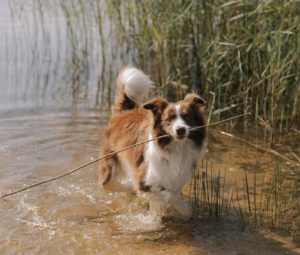Summer in West Michigan is a time for fun in the sun, and for many families, this includes spending time around pools, lakes, and rivers. While water activities can be enjoyable for both humans and pets, it’s essential to ensure that our furry friends stay safe. Here at Family Friends Veterinary Hospital, we want to share some crucial tips on keeping your pets safe around water.
Understanding Your Pet’s Swimming Ability
Know Their Limits
Not all pets are natural swimmers. Breeds like Labradors tend to be strong swimmers, while others, such as Bulldogs and Dachshunds, may struggle. Before allowing your pet near water, understand their swimming abilities and supervise them closely.
Introduce Gradually
If your pet is new to swimming, introduce them to the water gradually. Start in a shallow area and let them get comfortable at their own pace. Use positive reinforcement and encouragement.
Pool Safety Tips
Supervision is Key: Never leave your pet unsupervised around the pool. Even strong swimmers can become tired or disoriented.
Secure the Pool Area: Install a fence around your pool to prevent unsupervised access. Ensure the gate is always closed and secure.
Teach Exit Points: Show your pet where the pool’s exit points are, such as steps or a ramp. This can be a lifesaver if they accidentally fall in.
Use Pool Alarms: Consider installing a pool alarm that will alert you if there is unexpected activity in the pool.
Lake and River Safety TipsUse Life Jackets: Just like humans, pets can benefit from wearing a life jacket, especially in unfamiliar or deep water. Ensure it fits properly and is comfortable.
Beware of Strong Currents: Lakes and rivers can have strong currents and undertows. Keep your pet on a leash in these environments and avoid areas with fast-moving water.
Check Water Conditions: Be aware of water quality issues such as blue-green algae, which can be toxic to pets. Avoid areas with visible algae blooms and check local advisories.
General Water Safety Tips
Hydrate: Ensure your pet has access to fresh drinking water to prevent them from drinking pool or lake water, which can contain harmful chemicals or bacteria.
Rinse After Swimming: Rinse your pet with fresh water after swimming to remove chlorine, salt, or contaminants that can irritate their skin.
Watch for Signs of Fatigue: Swimming is great exercise, but it can be tiring. Watch for signs of fatigue, such as heavy panting or difficulty swimming, and give your pet regular breaks.
First Aid Knowledge: Be prepared for emergencies by learning basic pet first aid, including how to perform CPR on your pet. Keep a first aid kit handy and know the location of the nearest emergency vet.
Signs of Water-Related Issues
Even with the best precautions, accidents can happen. Be vigilant and watch for signs of trouble, such as:
- Coughing or Difficulty Breathing: This could indicate water inhalation or a near-drowning experience.
- Vomiting or Diarrhea: Drinking contaminated water can lead to gastrointestinal issues.
- Skin Irritation: Prolonged exposure to pool chemicals or natural contaminants can cause skin problems.
- Lethargy or Weakness: This could be a sign of exhaustion or a more serious issue like water intoxication.
Conclusion
Water activities can be a wonderful way to bond with your pet and keep them active during the warmer months. By following these safety tips, you can ensure that your time by the pool or lake is enjoyable and safe for everyone. At Family Friends Veterinary Hospital, we’re here to support you with any questions or concerns about your pet’s health and well-being. Have a safe and happy summer with your furry friends!
If you have any questions or need further advice, don’t hesitate to contact us at Family Friends Veterinary Hospital. We’re always here to help you ensure your pets are safe and healthy. And feel free to share this blog with fellow pet owners to spread awareness about water safety for pets!






